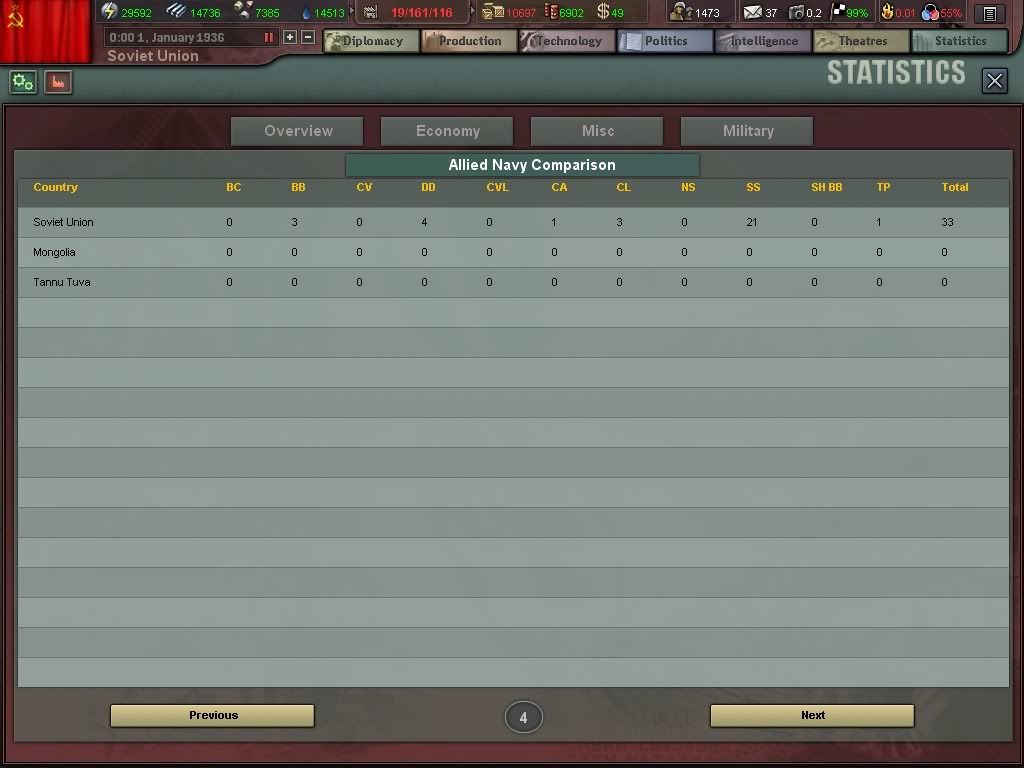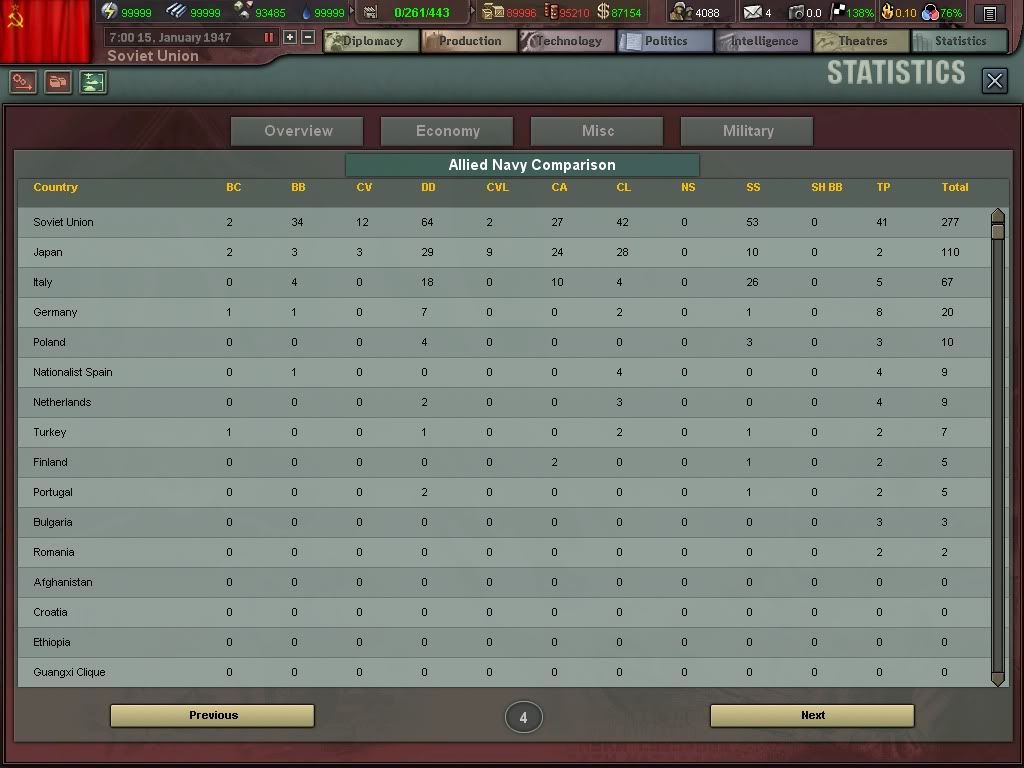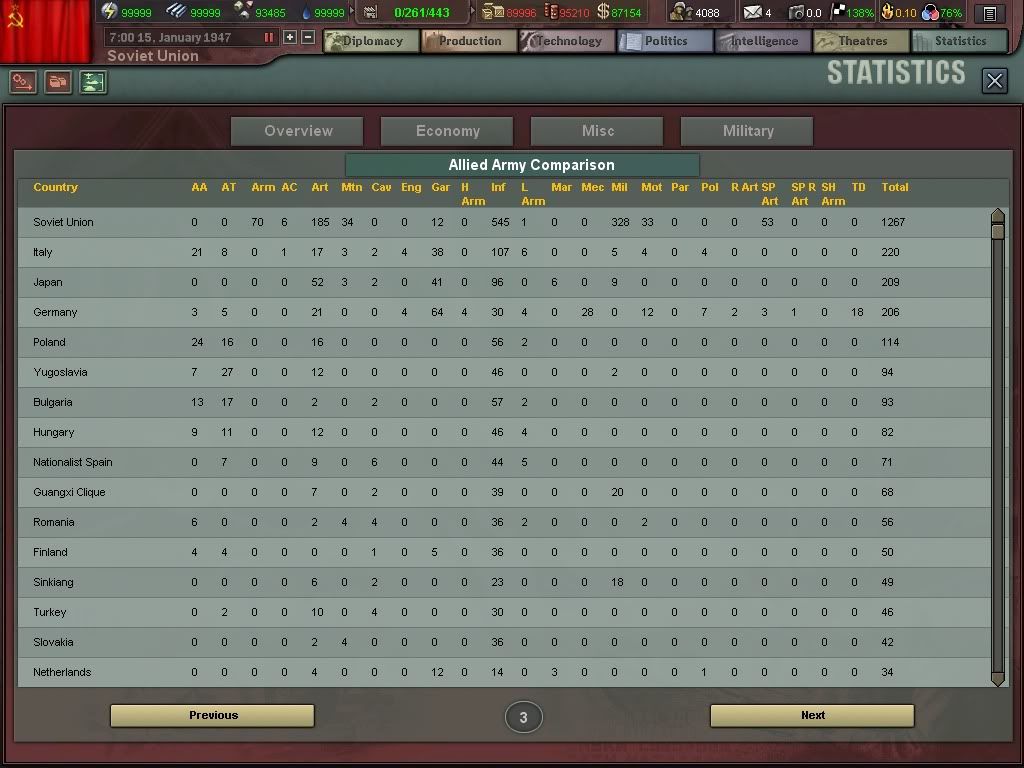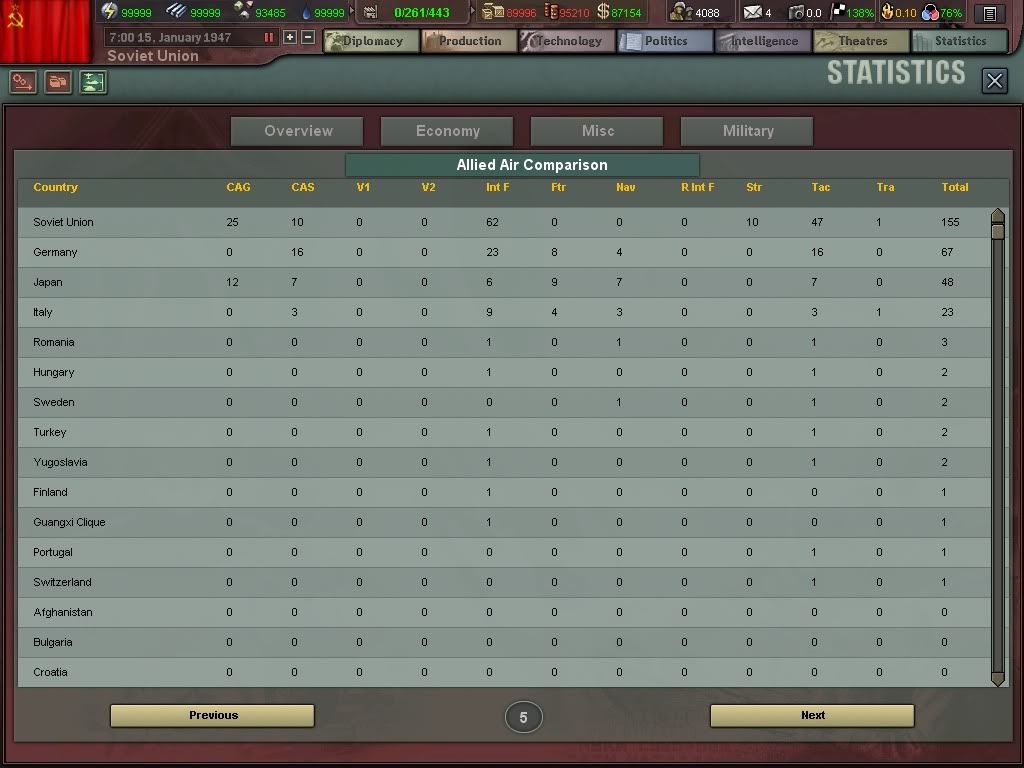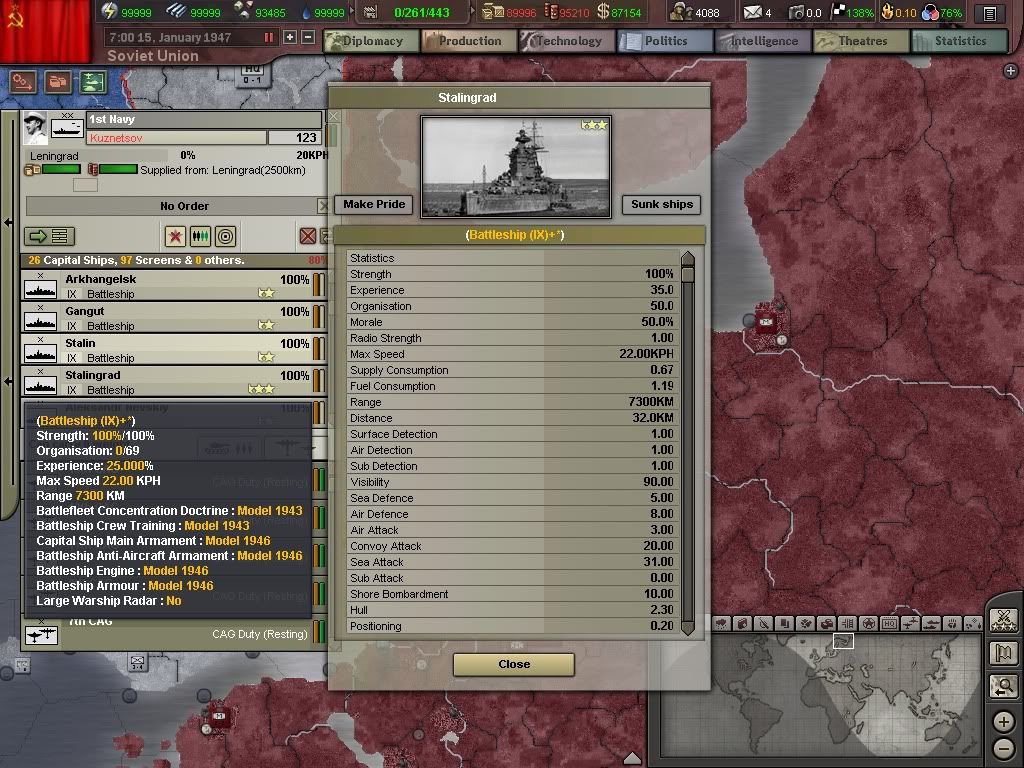Alright, the Soviet experiment is complete. I achieved success (easier than I though, actually).
In HOI3 terms, Stalin's plan is doable. In order to achieve success, you need to stay at war constantly once the Axis attacks. The extra IC from total mobilization is important, but since naval vessels take forever to build, Heavy Industry Emphasis is so very important in shaving time off construction. By implication, the Purge is necessary, otherwise you won't have the unity to enact Heavy Industry Emphasis.
Phase one was no sweat. Of course, we easily hit the Great Army mark before war with Germany. I did 2 1/2 IC runs. The first two were in 36 and 37. Then, when I engaged Heavy Industry Emphasis during the Winter War with Finland (1938), I fired up another partial run just to take advantage of the laws. Aside from that, I only cooked a few ships in most categories for practicals, while focusing on land and air power prior to the war.
When Germany attacked, I was not able to engage phase 2 as quickly as I would have liked, due to much larger upgrade costs than I anticipated. The upgrade from LARM and CAV to ARM took longer than I anticipated as well (lower than usual armor practicals because I was not rushing to get really nice armor). However, Germany obliged me by playing a lousy game. Despite setting up defensive lines on rivers, the AI felt it necessary to send HARM against me, trying to use brute force to cross the rivers. German air forces badly damaged most of my CAS, but my INTs contested the skies effectively. The Germans even let me keep Marat off the Baltic coast, providing shore bombardment while the German navy and air force did nothing. The only naval action at this stage in the war was when the plucky little Romanians sent their one NAV repeatedly against my Black Sea Fleet.
Before December of 41, we had liberated Poland and taken Danzig. Romania was puppeted when the German army advancing on Stalingrad refused to turn around and help out their allies. This resulted in a huge pocket that took half a year to clear.
By 42, I had added a ton of aircraft to the queue, but also CAs were entering full production. All CAs produced by the Soviets this game used WWI techs. They exist solely to fulfill Stalin's plan and to generate cruiser practicals.
By 43, most of the Axis was puppeted, aside from Japan. I hit Great Air Force and Grand Navy this year.
By 47, the war is dragging on as I take out unaligned minors just to keep Heavy Industry Emphasis.
And the results:
And just to make sure you know I built proper air and land forces.
Now, the Soviet Navy looks awesome on paper. It rivals the historically powerful war-time production of the USN. But underneath those numbers lay dark secrets.
1) All those subs are pre-1943 techs. Their hulls and engines make them unsuitable to force projection in a Cold War setting. They will have to be scapped and new ones built.
2) All CVLs are WWI era hulls and engines. They are only suitable for training or target practice. I built them while I researched the full CV tech to generate some carrier practicals. They served their purpose, but they are garbage.
3) All CVs are pre-1940 hulls and engines. Their CAGs are awesome, thanks to Soviet light aircraft practicals and techs, but they are all too slow to engage in fleet operations with modern ships. They will have to be scrapped (a new set of 9 CVs is in production as of the screenshot, so it's not all bad).
4) All CAs are WWI tech. They were only built to satisfy the plan and to generate practicals for the CLs. Sell them for scrap.
5) All BCs are WWI tech. They are only good for scrap. I built them to generate capital ship practical early in the war.
6) About 1/3 of the DDs are pre-1941 techs. They have upgraded ASW and RADAR, but they are too slow to keep up with newer ships.
7) About 10 of the CLs are in the same condition as the DDs. They are unsuitable for Cold War operations.
8) About half the BBs are level 3 or worse, making them unsuitable for Cold War operations. And remember, 3 of the BBs on that list date from before the Revolution! (They never got sunk, even when shelling Germany for years on end.)
Now, the good news.
The BBs completed in January of 47 look like this.
Soviet CAGs, despite never firing a shot, are awesome thanks to supplementary research from light aircraft. That means that whenever those newer CVs are finished they will be able to terrorize the oceans. The USA had better be careful during the Cold War.
Some thoughts:
As anyone who has played the Soviets knows, the real limiting factor for land and air forces is logistics. The USSR can spam INF/ARTY and INT/CAS all day, but in the end, unless you also spam infrastructure and supply techs, you can only keep so many units supplied sufficiently to be a credible threat against either Germany or Japan. In particular, invading Manchuria and Korea renders Soviet manpower and IC superiority somewhat moot; build all the brigades and wings you want, but you aren't moving all of them through Asia.
This means that any Soviet naval plan has some built in IC slack from the beginning it can take advantage of. Even on VH, with its associated IC and resource penalties, a semi-skilled Soviet player can produce more land and air units than can be utilized effectively. So, in that sense, what else are you going to spend your IC on, but a navy? Even at its worst, a Soviet player can dedicate 100 IC a day to keep upgrades humming along and still have plenty left over to build new things. Furthermore, spamming brigades costs leadership, which is more of a finite resource than IC for the Soviets (assumes the Purge was enacted).
What makes the navy difficult is that Soviet naval techs are so bad, and practicals are so bad, that you waste a disproportional amount of leadership trying to even get marginal techs, to say nothing of cutting edge technologies. In order to get decent techs, you have to trade IC for research: build useless ships just to get practicals to speed up research and build newer ships. Again, luckily for the Soviets, IC is not a real issue and it is a viable strategy to trade IC for research.
I considered taking the SHBB route. I've done it before with the Soviets, but I didn't do it this time. Yes, the Soviet BBs planned were to be bigger than Yamato, but if you examine the screenshot, the BBs I finished in 47 have a much higher hull rating than Yamato, more firepower, are faster, have mo operational range, and more AA. Basically, the Soviet BBs I built make treaty battleships look like wimps, which was the point of Yamato anyway.
Given Soviet limitations in leadership, in a real game, I would streamline the Soviet navy along BB lines and dispense with subs and carriers. The reason is that my doctrines are crap in this game. You'll notice that the BB has 1946 guns and engines, but 1943 doctrines. It's even worse for subs and CVs. If you could see my air doctrine page, you would be aghast. In other words, the limitations of Soviet leadership make naval specialization a must, not IC limitations.
A final thought:
Stalin's naval build plan only works because he can impoverish the Soviet people using a war time economy. The people of the Soviet Union faced real hardships during the war, and the increased IC efficiency and output, and reduced consumer goods demands, simulates their sacrifice (as it does for all other war time powers). Without the ability to force the population to accept these sacrifices, his build plan seems unreasonable unless you totally abandon the army and air force. Without practicals, naval build times are atrocious, and it is much easier to build those practicals by using Heavy Industry Emphasis to substantially cut build times. Furthermore, the plan only works because the Germans and Japanese can't bomb ships as they are being built. In the real world, Stalin's plan was sensibly abandoned when the war broke out, but I don't see how it would have been successful without a war time economy.


